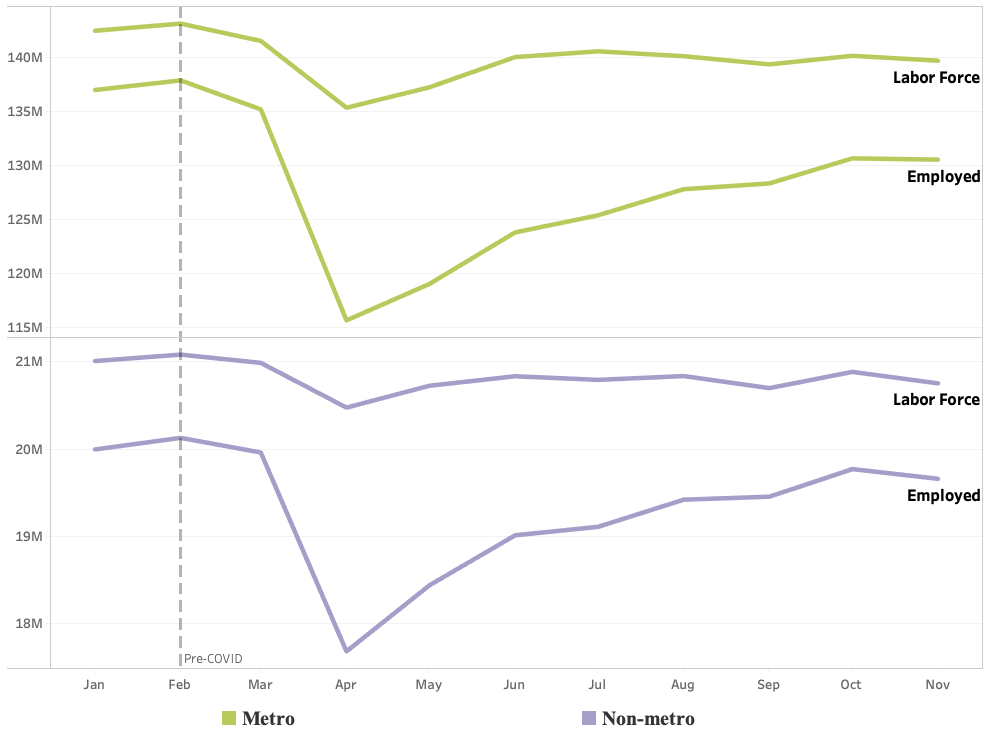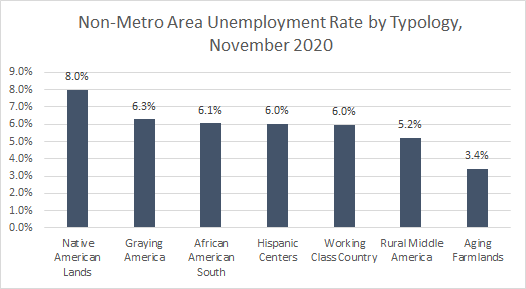CORI’s Employment Impact Update: November 2020
Each month in our Employment Impact Update, we share key findings, trends, detailed maps and analysis based on BLS monthly employment data to help you understand what’s happening to rural economies.
COVID-19 continues to have an unprecedented impact on the national economy. While the vast majority of pandemic-related coverage has focused on dense urban areas, smaller towns across the country have also felt deep health and economic shocks. Each month in our Employment Impact Update, we share key findings, trends, detailed maps and analysis based on BLS monthly employment data to help you understand what’s happening to rural economies.
Below are our key findings from the November data, released January 8, 2021. You can also explore our employment impact map in full below.
Figure 1. Employment change (%) from February (pre-COVID) to November (current release).
Topline takeaways
November was a difficult month for rural economies — and the economy as a whole. Rural areas lost jobs and have yet to recover to pre-pandemic employment levels.
And within rural places, there are significant disparities. Rural Black, Hispanic, and Native communities face the greatest employment challenges. And while some rural areas seem to be bouncing back, others — like in Colorado — faced steep monthly job losses.
Headline employment numbers
Non-metro
- Non-metro areas lost ~110,000 jobs from October to November, bringing the non-metro employment rate down by 0.6%. Overall, non-metro employment is still 2% lower than it was in February 2020.
Metro
- Metro areas lost ~120,000 jobs from October to November, decreasing overall metro employment by 0.1%. Overall, employment in metro areas is still down 5% compared to February 2020.
In rural communities of color, employment recovery is uneven and deteriorating
Based on the “community types” defined by the American Communities Project, we can see that rural communities with more Black, Native, and Hispanic residents face serious employment risks. Native American Lands communities have the highest rural unemployment rate of 8% — exceeding the national average of 6.7%.
African American South and Hispanic Centers communities also have higher unemployment rates than community types with higher shares of white residents, such as Rural Middle America and Aging Farmlands.
Since July, there have been some signs of hope, but the last months of the year brought on a renewed decline in employment. Almost all types of communities saw consistently positive employment growth from July through October, but since then, most types of communities have been losing jobs each month. Hispanic Centers have faced the sharpest drop, with employment falling almost 2% from October to November.
These end-of-year declines are troubling, as there is typically an uptick in late fall hiring for seasonal and holiday work. This lack of a year-end bump indicates COVID-19’s persistent impact on the economy, as the shift away from brick-and-mortar retail to online commerce and home delivery continues to reverberate.
Part of the racial disparities we can see in employment can be explained by inequalities in access to remote-friendly jobs. BLS data on tele-working shows that while 21% of White employed workers worked remotely in November, just 18% of Black workers and 13% of Hispanic workers did so. These remote work stats also help explain why Graying America communities faced elevated unemployment: 72.5% of people who teleworked because of COVID-19 are between 25-54 years old, suggesting that older workers are having more trouble transitioning to remote work.
Overall rural recovery is geographically uneven across the country
From just the topline employment numbers, it might seem like rural economies have consistently rebounded more strongly than metro economies. However, this trend does not hold everywhere. Take Colorado: From October to November, non-metro employment in the state fell by 5%, while metro employment grew by 0.1%. And since February, non-metro employment is still down 11.5%, while metro employment is down just 4%. The state is an important reminder that “rural” and “metro” economies aren’t monoliths, and that local leaders and policymakers need to be attuned to specific local conditions in order to respond to the divergent effects of the coronavirus pandemic.
As the coronavirus continues to rage across the country, we will continue monitoring the employment situation, and to advocate for sustained investment into the rural and urban places across the country that still need to get back on their feet.
Rural data matters
We’re in the midst of an economic crisis, and we aim to use these monthly datasets, in conjunction with our on-the-ground-knowledge and rural expertise, to help understand and predict what’s next for rural America–and equip leaders and policymakers with the tools to respond effectively. That’s why rural data like this is so important.
This data and our visualizations provide crucial insights into understanding what’s happening in rural America—insights that urban-focused or aggregated data often omit. If you’re a community leader looking to integrate this data to communicate with local stakeholders, see our tips for using data to tell your story.
Stay connected
And if you’re looking to respond to this economic crisis by pivoting to a more resilient digital economy, check out our toolkit for assessing your digital ecosystem, or contact us to learn how we can help.



